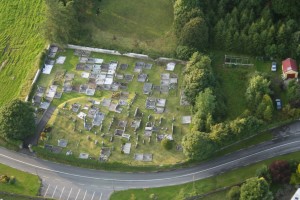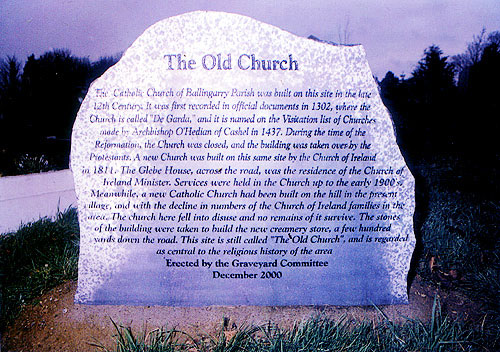Ballingarry Old Church

The Settlement and Architecture of Later Medieval, Slieveardagh, County Tipperary.
Richard Clutterbuck Volume II – Ballingarry Old Church.
This thesis is presented in fulfilment of the regulations for the degree of M.Utt in Archaeology, University College Dublin. – Head of Department: Supervisors: Prof. Barry Raftery: Dr. Tadhg O’Keeffe: Dr. Muiris 0’Sullivan – August 1998
Ballingarry Castle, Ballingarry Td., Ballingarry Pr. 55/2, 16, S 298 486, Tl055-015, 1/1997
Location Ballingarry is situated in the south centre of the study area in the hills overlooking a tributary of the upper reaches of the Kings river approximately 1.25 km from the modern village of Ballingarry. The site is at the cross roads between the Bohir Mor and the road running north along the Kings River valley (Fig. 38). The land is mostly used for grazing today. The Civil Survey identified the land quality as suitable for dual purpose, with an emphasis on pasture (Civil Survey I, 113).
Ballingarry Castle was sited at an altitude of 160 metres on ground sloping gently to the west. The surrounding area appears as high ground between two small river valleys with a sharp drop to the immediate north. Ballingarry castle had a south-westerly aspect with a commanding position over the road.
History: Ballingarry was recorded as being in the possession of Nicholas Fanning of Ballingarry in 1641 (Civil Survey I, 113). Fanning was part of a powerful land holding family in the parish of Ballingarry from the medieval period to the seventeenth century. The castle is recorded as being in good repair in 1654 with a thatch house and some cabins associated with it. The castle and settlement at the centre of the parish is not depicted on the Down Survey maps.
Description: Nothing remains of Ballingarry castle site except for a roughly rectangular pile of rubble consisting of field stones measuring 24 metres by 21 metres. The castle was destroyed to provide material for the Catholic Church in Ballingarry village in the nineteenth century (personal communication with a local). The site of the castle also has a lot of mortar but no cut stones. There is little or no evidence of a bawn, although the field in which the castle was sited is at a higher level to the adjacent field to the south and may have originally been an irregular enclosure.
Comment: The area of the rubble probably does not represent the original size of the Castle. The castle was probably a tower house and residence of the main land owning family in the Parish: the Fanning’s.
Ballingarry Church, Ballingarry Td., Ballingarry Pr., 52/2, S 308496, Tl055-016, 4/1997
Location, Ballingarry is situated in the centre of the study area in the hills overlooking the upper reaches of the Kings River (Fig. 38). Ballingarry church site is in a graveyard adjacent to the main road running through Ballingarry; an Bohir Mor. The church was sited at an altitude of 160 metres approximately 1.25km west from the modern village of Ballingarry and 148 metres south of Ballingarry castle site.
History: Ballingarry church or De Garda was valued at 10 marks in 1302/07 in the ecclesiastical taxation (Cal. Doc. Ire. 1302-1307, 285). In 1437 Ballingarry church was mentioned in a list of Procurations for the Diocese of Cashel and Emly when it was taxed for 24 shillings (Seymour 1908, 331). The perpetual vicar of Ballingarry, Dermit Oconayn, was the subject of a Papal Mandate in 1478 when he was accused of celebrating mass under sentence of excommunication as well as leaving his parishioners to die without confession or communion and allowing the roof and walls of his church to fall into ruins (Cal. Papal. Regis. xiii, 606; Hennessy 1985. 69-70). By 1478 the Prior of St. Catherine the Virgin Waterford held the rectory of Ballingarry (Hennessey 1985, 69). When the Priory was dissolved in 1540-41 it possessed two thirds of the tithes worth £8 and one twelfth of the vicarage of Ballingarry and Famyn Wood (Extents Ire. Mon. Possessions, 344). In 1607 Ballingarry vicarage was returned as void and destitute of incumbents (Cal. State Papers 1606-08, 241) and in the 1615 Royal Visitation of Cashe1 and Emly Ballingarry church and chancel appeared to be standing but there was no service and the vicarage was vacant (Murphy 1902, 290, 302). In 1640 Ballingarry had two acres of arable and pasture glebe land on the east side of the church and fenced with a ditch, worth £5 (Civil Survey II, 399)
Description: There are no upstanding remains of the medieval Ballingany church. A raised area in the grave yard may be the remains of a church ,however, it is impossible to date (Fig. 34). A church depicted in the 25″ 0.5. map in the grave yard is probably an eighteenth or nineteenth century Protestant church which has subsequently been destroyed, its stones used to build the local co-op. The grave yard contains graves from the eighteenth century to the modem day. Bal1ingarry church appears to have been in a poor state in the late medieval period. The church is recorded as being in ruins in 1478. By the early seventeenth century Ballingarry church did not appear to have a resident priest though the church is recorded as upstanding.
Comment: Ballingarry medieval church functioned as the parish church. The church appears to have been in ruins at the end of the fifteenth century but was reconstructed, possibly by the Fanning family who Ballingarry tower house (2) nearby.
Ballingarry Settlement, Ballingarry Td., Ballingarry PI’., 55/2, S 298486, Tl055-014-16, 1/1997
Location: Ballingarry is situated in the south central portion of Slievem’dagh, within the Slieveardagh hills. The site of the settlement overlooks the upper reaches of the Kings River Valley and lies approximately 1.25 km. west of the modern village of Ballingarry. The site of Ballingmry settlement is at an altitude of approximately 160 metres, in a sheltered position on a rise between the main road through the Slieveardagh hills called an Bothir Mor and a deep stream valley.
History: Ballingarry settlement was associated with tlle Fanning Family in the later medieval period. In 1512 Geoffry Fanning was described as the Lord of Ballingarry (Orm. Deeds IV, 71). Geoffry Fanning was probably the free holder called to the Liberty Court of Tipperary in 1508 as ajuror (Orm. Deeds IV, 329). A church (3) was at Ballingarry since 1302 (Cal. Doc. Ire. 1302-07,285). In 1478 the church was recorded to be in ruins and the parish priest was excommunicated (Cal. Papal Regis. xiii, 606; Hennessy 1985, 69-70). A church with its nave and chancel appear to have been standing in Ballingarry in 1615, but without services (Murphy 1902,290,302).
The castle of Ballingarry was probably built by the Fannings. In 1654 Nicholas Fanning, an Irish Papist was recorded as the proprietor of Ballingarry and the settlement at the centre of the parish was described:
“Upon the sayd lands stands a good castle with a tatcht house & some cabbins and a mill standing upon a little brooke neare the castle”. (Civil Survey I, 113)
Unfortunately the Down Survey Parish map depicts no structures in the townland. The Fannings were one of a few families to retain their land after the Cromwellian confiscation’s. In the census of c. 1659 a Jeffry Fannying Esq. is retumed as the principle land owner of Ballingarry townland (Pender 1939,295). In 1667 Jeffry Fanning paid taxes for three hearths, including an oven and a kiln (Laffan 1911, 135).
Description There are no upstanding architectural remains at Ballingarry. The physical remains consist of the tubb1e foundations of the castle or tower house and 148 metres away the church site, within a grave yard still in use today. Between the castle site and the church site are a number of earthworks, which probably represent the site of the thatched house described in the Civil Survey (Civil Survey I, 113). The deep stream located to the north of the settlement site provided the mill race for the mill described in the Civil Survey (Civil Survey I, 113). The stream has slight evidence for a retaining stone wall on channel the stream and may also have had a holding pond. The actual site of the mill is not located. The whole settlement was located besides the main road through the Slieveardagh hills from Kilkenny to Cashel, called an Bothir Mor. The settlement remains appear then to be mainly confined to between the road and the deep stream.
Comment The size of the area occupied by Ballingarry settlement was small. The historical record and the remains on the ground show that the settlement was dominated by the Fanning tower house (2) and other buildings owned by them. The settlement site had a church (3) at least since the fourteenth century, probably since the initial Anglo-Norman invasion and possibly as a pre-Norman church site. However, by the late fifteenth century the church was in ruins and the priest was abusing his powers. The Fannings were associated with Ballingarry from the early sixteenth century, possibly when they built their tower house. The choice of site was influenced by the presence of the parish church. The settlement described in the Civil Survey appears to be a wealthy farmstead with services and functions for a pastoralist estate. Any nucleation at the centre of the parish was sponsored by Fanning family, either for their own use, the functions of the estate or as houses for the worlanen of the estate.

